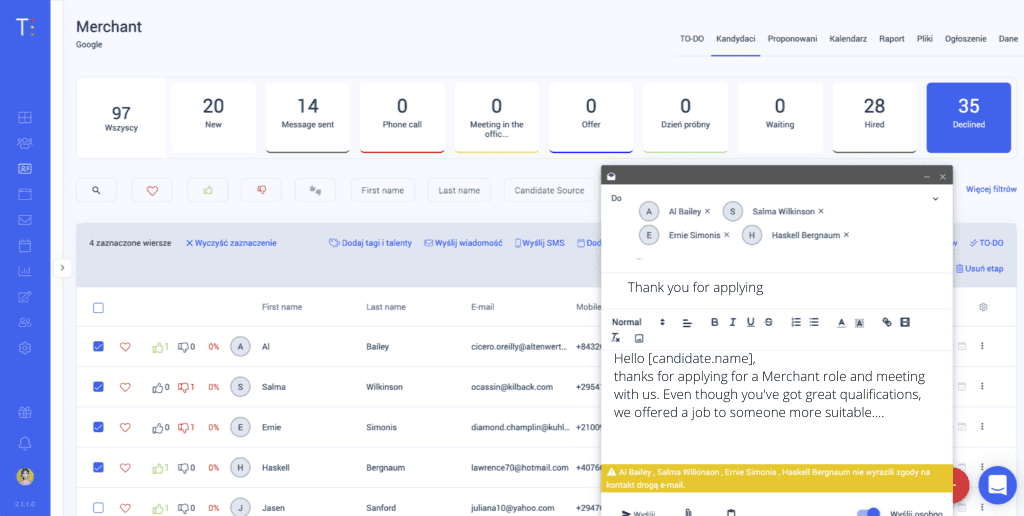Recruiter’s work provides a lot of contact with people, supporting talents and careers, and gives a lot of satisfaction, especially when you know that thanks to you someone has just got their dream job. But there is also the other side of the coin – rejection of the candidate. This is the moment when you have to say: ‘No, we do not want you to work for us’ without creating a bad impression of your company. So how to reject with flair?
Respect the candidate and the candidate’s time
Feedback is a must, regardless of whether the candidate moves on to the next stage of the recruitment process or not. Some may even want feedback to be legally required, what we wrote about on our blog lately. If you reject a candidate at the very beginning, do not wait until the CV collection process ends and give him immediate feedback. Remember, time is money – while waiting for your feedback, the candidate may reject or postpone the next stages of recruitment processes in other companies. Instead of holding him in abeyance for weeks, inform him immediately about any change of his status in your recruitment process. Good communication with candidates improves the candidate experience and thus works for employer branding.
Using Traffit, you can let the candidates know about the rejection easily – all you have to do is to select the candidates from the list and send them an email. With Traffit, each message will be sent separately and will be personalized.

Moreover, you do not have to do it manually. You can simply set up automatic notifications to be sent to candidates each time they are marked with Rejected status.
Obviously, the automatic messages will be personalized and will include details about the recruitment process that the rejected candidates have participated in. You can fully customize the content, timing of sending the message, and the sender. Owing to that, your communication with rejected candidates will remain personalized and you will spend less time on it.
Always state a reason why a candidate is rejected
Most candidates want to know the reason for rejection in the recruitment process. Sometimes it is all about curiosity, but in most cases, substantive feedback motivates them to work on themselves and avoid mistakes in the future. Additionally, owing to appropriate feedback, the rejected candidate can better understand his failure in the recruitment process and also appreciate your time spent on feedback. These days, recruiters provide such information only at the explicit request of the candidate, but it starts to change.
Adding a note when a candidate is rejected will allow you not only to give him specific feedback later but also to thoroughly analyze the most common reasons for rejection. For example, if a frequent reason for rejection of candidates is a mismatch between the candidate’s skills and the position, it is then worth considering rebuilding job advertisements or application forms.
Receiving the specific information about the reasons for rejection is an important signal for the candidate that his application has been read carefully and his candidacy for the position has been analyzed.
Stay in touch with the rejected candidate
The fact that the candidate has failed to move on to the next stages in the recruitment process does not necessarily mean that he will not be interested in another position or will not apply again in the future. What can you do to prevent the candidate from getting discouraged after rejection and to provide a positive impression of contact with your company?
- Thank the candidate for participating in the process and inform him that his CV remains in your database for future recruitments,
- Provide the direct contact to the recruiter so that he can contact him with questions (e.g. about the reason for rejection) and any comments,
- Remember about the candidate in the subsequent recruitments and inform him about it – owing to this, he will know you remember him, and, additionally, you will increase your pool of candidates for future recruitments.
How can you do it with Traffit? Besides the standard search of candidates, you can, for example, generate a list of candidates who participated in a specific recruitment stage, such as a phone conversation with a recruiter. Having the list generated, you can select the candidates and send them all an email like: ‘Good morning, You participated in recruitment process X. Perhaps you will be interested in our new job offer…’. The candidate who receives such a message will certainly be more likely to apply, despite being rejected in the earlier process.
Rejection of a candidate does not have to destroy the candidate experience
Do not let the candidate’s failure to recruit discourage him from applying to your company again in the future. Since the candidate has applied to you once, it means that you are an attractive employer for him – do not let him change his mind on this matter. By paying attention to every stage of the recruitment process, you can actively improve candidate experience and attract the best talents. We do not want you to take up this challenge alone – our ATS (applicant tracking system) will help you automate some of the tasks and focus on people.


